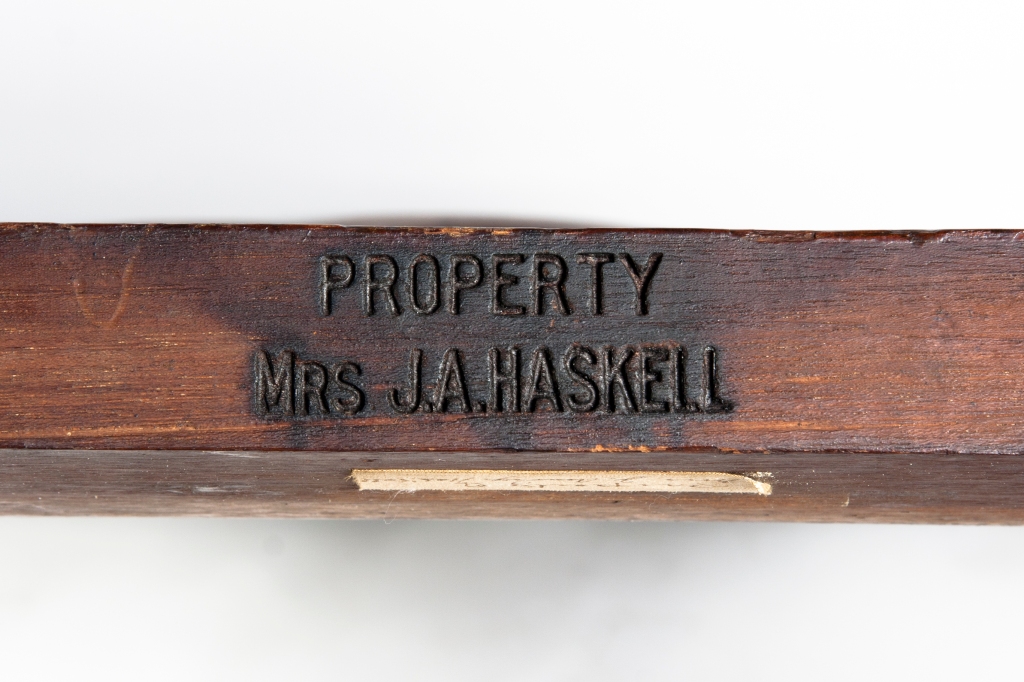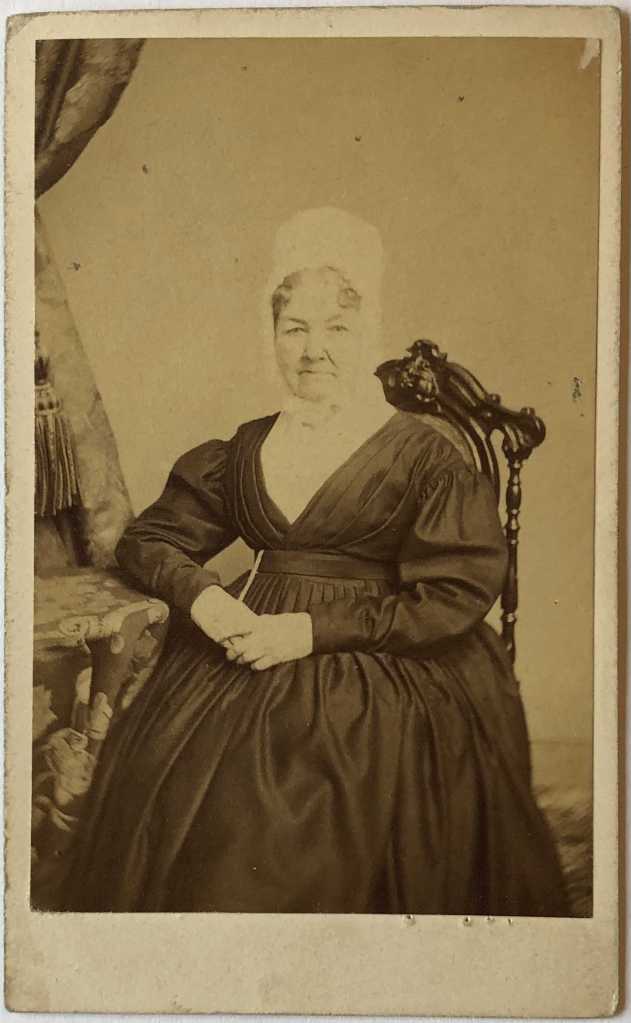There are two other marks on the mid-eighteenth-century Philadelphia armchair in the previous post. The mark G. B. Wood can be found on the lower surface of both the front and rear seat rails.


The auction catalogue note for the armchair describes both the marks on the bottom of the loose seat and the seat frame as “impressed,” but this is inaccurate and possibly misleading. The names and dates on the bottom of the loose seat are carved with carving gouges and chisels in a conventional serif font commonly used by woodcarvers. John & Mary Ann Bacon 1801 is the most competently carved inscription. Geo. B. Wood 1859 is perhaps the least successful of the three carved inscriptions. The differences in carving technique of the three inscriptions suggests that they were carved at different times by different carvers, possibly near in time to the dates associated with the names as the catalogue note proposes.

The G. B. Wood marks on the bottom of the seat rails appear not to be carved but rather made with a branding iron. We don’t know what precipitated Wood’s purchase of a branding iron. Did he already own it and use it to mark possessions before he inherited the armchair or did he order it specifically after acquiring the chair? Did he mark other objects with it and if he did, do any of them survive? Interestingly, he branded the chair in two places; in my experience the majority of brands on furniture are singular.


The catalogue note for the armchair posits that Job Bacon (1735-1801) was the “earliest known owner of this chair” and that “his son John Bacon (1779-1859) is the next recorded owner on the slip-seat frame” because the inscription John & Mary Ann Bacon 1801 is associated with Job Bacon’s death date. In truth, John Bacon, along with his wife Mary Ann are the first “recorded” owners on the slip-seat frame and 1801 is also the year they were married, which was not noted in the catalogue essay. It is possible John Bacon inherited the chair from his father, Job, but I suspect it is likely John and Mary Ann had the first inscription carved on the chair in celebration of their wedding year as they continued to mark their wedding anniversary over the decades with commissioned objects until John’s passing, some of which they would present to their children.
A number of these objects survive. In 1844, John and Mary Ann commissioned a box veneered in elm from the Penn Treaty Tree that fell during a storm in 1810. The box was presented to their son, Francis Bacon (1824-1910), “in the remembrance of the unabated affection of his Parents on the 43rd anniversary of their marriage. 1844 9th month 22nd”

The following year they had a daguerreotype portrait of themselves “Taken Ninth month 22nd 1845 being the 44th anniversary of our marriage.” James Francis Wood (1846-1929), one of John and Mary Ann Bacon’s grandsons, and the younger brother of George Bacon Wood, would make a photographic copy of the original daguerreotype for a family Christmas card in 1910.
Philadelphia is arguably the birthplace of photography in America and the Bacon’s portrait was made just six years after Joseph Saxon of Philadelphia produced the earliest surviving photograph made in the United States. Later in 1839 Robert Cornelius, a Philadelphia metal worker and lamp maker recorded his own image in what is thought to be the earliest extant portrait and first “selfie.” Cornelius would open a portrait studio in 1840 with his silent partner, Dr. Paul Beck Goddard, who had discovered that bromine in combination with iodine was more light sensitive to light than iodine alone, allowing a shortened exposure time for daguerreotype portraiture.


Inscriptions on the back of John and Mary Ann Warder Bacon’s marriage certificate continue their family story. Decades of family births, deaths, and marriages are recorded. One section celebrates another anniversary,
“Favored by our merciful Heavenly Father to complete on this day, Ninth month 22nd.. 1852. The fifty first anniversary of our marriage, in the Enjoyment of Excellent health, & unusual activity of body, we have deemed it Expedient on this occasion to convene our Children, (with the Exception of our son J. Murray Bacon & family now residing in the State of Illinois) grandchildren, as well by immediate descent as by intermarriage, and our only great grandchild, the daughter of our grandson Joseph K Bacon, to commemorate the day with becoming order, and we trust, with gratefull hearts for the many blessings vouchsafed to us.”
[signed] John Bacon 73 yrs 18 days, [signed] Mary Ann Bacon 70 . 7 . 22
The family had assembled at John and Mary Ann’s home at 117 Race Street and their children and grandchildren signed their names including their grandchild Geo. B. Wood, age 20, but not his mother, Elizabeth Head Bacon Wood, who had died six years earlier at age 39 when George B. Wood was 14 years old.

John and Mary Ann Bacon were not the only Bacon family members who thought to memorialize objects in their possession. William Henry Bacon (1815-1882), the fourth son of John and Mary Ann Bacon to survive to adulthood, had a Philadelphia wainscot side chair inscribed in white paint on the bottom of the seat board – “THE Wm. PENN CHAIR/The property of Wm. H. BACON.” It is unknown where he acquired the chair, or when he had it inscribed. What is important is that he believed it was once owned by William Penn and so had a special importance aside from its intrinsic value as part of the history of woodworking in Philadelphia.


John and Mary Ann Bacon continued to patronize Philadelphia photographers over the years to have their portraits made. Mary Ann Bacon sat for her last portrait the year before she died. Most of the portraits are still with family members and a few have been uploaded to Ancestry.com.



Bacon descendants have used the Internet to research possessions that have left the family. In 2020, an image of an armchair that sold at Christie’s in January 2016 was posted on Ancestry.com described as the chair belonging to John and Mary Ann Bacon. But this is not the Bacon’s chair, which was sold at Christie’s in 2022, two years after this posting. The armchair on Ancestry.com is a chair formerly in the collections of the Philadelphia Museum of Art and the Wolf Family.

Although clearly related, and similar in its monumentality and many details, there are differing opinions whether the PMA/Wolf Collection armchair should be considered part of the set that includes the Bacon/Wood family chair.
The surprise of discovering the Bacon/Wood armchair was on loan to Stenton as we began to prepare for The Furniture Society program that took place in October sparked many thoughts about how I approach such an object these days. How to proceed to give an account of engaging with an object that contains great craftsmanship, that has been extolled by many, has lovingly passed through generations of family hands, and yet still contains copious mysteries.
This is just a small part of the story, we’re just at the beginning. I’ve not yet said not a word about the joinery or the design of the chair. How was it made, and why? This venerated armchair is more of a puzzle than any auction catalogue essay would have you believe.
As ever, furniture – is never just furniture.

